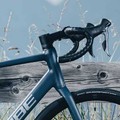
Bottom Bracket Buying Guide
Here at Sigma Sports, some of our most frequently received questions relate to bottom brackets, particularly choosing the correct option. As a result, we have put together this guide, outlining the differences between the bottom bracket standards, intending to clarify this notoriously confusing subject.
If you need any advice or help with bottom brackets, book an appointment at one of our workshops and our experienced mechanics will be happy to help.
What is a bike bottom bracket?
The bottom bracket is located within a shell at the junction between the frame’s seat tube and the downtube. A bottom bracket comprises a pair of bottom bracket bearings, located on either side of the frame, through which the chainset axle is fitted, allowing it to spin freely.
Traditionally there was little choice regarding the bottom bracket types available, with variances limited to shell width, spindle length, and thread type. These days, however, it’s not quite so straightforward, with over ten ‘standards’ of bike bottom brackets, each claiming to be better than the other, it’s no wonder we are often at a loss.
This article will clear up exactly what is a bottom bracket on a bike and will take each variance, one by one, and discuss its key features and what to look out for when checking compatibility with your frame, and/or chainset.
Bottom Brackets for Carbon Fibre Frames
One of the main reasons for this influx of bottom-bracket standards is the popularity of carbon fibre frames. Many carbon frames, particularly those at the higher end of the price spectrum, are compatible with only one specific bottom bracket type, decided by the manufacturer during production. Generally speaking, manufacturers have chosen to step away from traditional threaded brackets and use Press-Fit bottom bracket designs on their higher-end carbon and aluminium frames.
Choosing your bottom bracket
Ultimately which bottom bracket you require will be determined by:
- The frame’s bottom bracket shell
- The chainset you are planning on using
Understanding the 'bracket standard' is crucial for compatibility. We will discuss each variance individually, its key features, performance benefits and the tools required for installation and removal.

Threaded Bottom Bracket
The fact traditional threaded bottom brackets have been around for over two decades, yet still appear on some of today’s top-end framesets speaks volumes about their performance and popularity. While more advanced designs have filtered into the market, many still like the simplicity and “creak-free” reliability these brackets are renowned for.
Threaded bottom bracket shells have internal threading, with frame bottom bracket shell widths varying from 68mm to 100mm, and in some cases, even wider. You must ensure you choose the correct width bracket to suit your chainset; the chainset's spindle width will determine the bracket required. The most common spindle diameter is 24mm, as found on many Shimano and SRAM offerings, however, the less common, dated, 17mm square taper variant also exists.
Types of Threaded Bottom Brackets
There are a few different types of threaded brackets, namely Italian threaded and British (also called BSA or BSC), with the latter being the most common. British variants use a left-hand thread on the drive side, whereas Italians use a right-hand thread on both sides. Generally speaking, if your frame is less than 15 years old, it will likely have a British bottom bracket.
The benefits of a threaded bottom bracket include compatibility with the largest range of chainsets, easy home maintenance, and longevity. However, threaded bottom brackets are often heavier than more advanced options such as the BB30.
Tools required
Park Tool BBT9 Bottom Bracket Tool - used to remove and install Shimano® Hollowtech II, Campagnolo Ulta-Torque, Race Face, FSA®, SRAM®, Truvativ®, Chris King®, and many other external bearing, threaded bottom brackets
Park Tool P-handled hex wrench - Quality 8mm P handle hex wrench

BB30 Bottom Bracket
Cannondale first introduced BB30 bottom brackets in 2006, allowing the use of chainsets with large 30mm spindles and oversized bearings, done in pursuit of creating a stiffer BB system. The BB30 is compatible with frames with no internal thread and large 42mm diameter BB shells. Mountain bikes use a 73mm wide shell and road bikes narrower at 68mm.
With BB30 brackets, a cartridge bearing is pressed straight into the frame shell, and guided into its correct location by a built-in snap-ring.
Using simple adapters, BB30 frame shells can also accept non-BB30 chainsets. These reducing bushings are relatively cheap and can simply be popped into the cartridge bearing to reduce its diameter to fit the smaller spindle sizes found on SRAM GXP and Shimano Hollowtech II Chainsets.
The key benefits of the BB30 system are its low weight and 30mm spindle diameter, which provides high levels of resistance against axle twist, in turn greatly increasing stiffness.
PF30 Press Fit Bottom Bracket
SRAM launched the PF30 standard after the release of the BB30 system. Similar to the BB30, the PF30 is a type of press-fit bottom bracket. The compatible frame shell width measures 68mm on road bikes and 73mm on mountain bikes, however, its diameter is larger at 46mm.
Aluminium or plastic assemblies hold the cartridge bearings in place. These are pressed directly into the frame, with their machined outer lip locating their position by stopping against the frame's shell.
The PF30 is designed around chainsets with a 30mm spindle but can be adapted to accept 24mm axles using reducing bushings.
Tools required
These tools can be used for both the BB30 bottom brackets and PF30 press fit bottom brackets.
Park Tool BBT-30.4 Bearing Tool Set - compatible with PressFit 30 (PF30), EVO 386, BBright and PF121 standard bottom brackets
A bearing press tool such as the Park Tool HHP3 Bearing Cup Press for installation


BB86, BB92 and BB121 Bottom Bracket
Designed around a threadless 41mm diameter frame shell, these brackets use bearings similar to those found in zero-stack headsets. The bearing assembly is pressed directly into the frame, using a lipped edge to position itself correctly against the frame shell face, taking into account the bottom bracket shell width.
The numbers following the “BB” in the name refer to the frame type each bracket is designed for, with 86mm pairing with road bikes, 92mm suited to mountain bikes and 121mm used in “fat bikes”. All three options work with 24mm two-piece chainsets such as SRAM GXP and Shimano Hollowtech II models.
Tools required
Park Tool BBT903 BB90 Bearing Tool for removal
A bearing press tool such as the Park Tool HHP3 Bearing Cup Press for installation

BB90 and BB95 Bottom Bracket
Trek introduced the BB90 and BB95 in 2007 which have a very similar design to an integrated headset. The bracket bearings aren’t housed within an assembly; instead, the frame is moulded to allow the bearings to be pressed directly into it. This system utilises two-piece chainsets with 24mm spindles and can be found on Trek’s higher-end offerings as standard.
The advantages are low weight, wider bottom bracket shells for increased stiffness and a simplified installation process.
Tools required
Park Tool BBT903 BB90 Bearing Tool for removal
A bearing press tool such as the Park Tool HHP3 Bearing Cup Press for installation

BBright Bottom Bracket
The BBright is Cervelo’s blend of the BB30 and PF30 designs, adapted to work efficiently with their frames. The bottom bracket shell is extremely wide but is not centered in the middle of the bike, instead, it is offset to accommodate the frame's large left-hand chainstay. The total shell width is 79mm, however, 45mm of that sits to the left, leaving only 34mm on the right-hand side.
BBright systems come in two variants, the first of which uses a 42mm internal shell diameter and works identically to a BB30 setup. The second is more similar to a PF30, with an internal diameter of 46mm and removable bottom bracket cups. Due to the unusually wide 79mm frame shell, extra care must be taken when choosing your chainset to ensure compatibility.
Tools required
Park Tool BBT-30.4 Bearing Tool Set - compatible with PressFit 30 (PF30), EVO 386, BBright and PF121 standard bottom brackets
A bearing press tool such as the Park Tool HHP3 Bearing Cup Press for installation

BB386 EVO Bottom Bracket
The BB386 EVO is also very similar to a PF30, using an internal frame shell diameter of 46mm and pressed-in bearings, however, its 87mm shell width differentiates it.
It is compatible with most modern chainsets and crank arms, and adapters are available to fit Shimano, SRAM and Campagnolo 24mm variants. Ensuring the correct crank arms are used is crucial for proper installation and performance.
With stiffness directly correlating to cross-sectional size, the 87mm wide BB386 EVO theoretically has the greatest levels of stiffness on offer.
Tools required
Park Tool BBT-30.4 Bearing Tool Set - compatible with PressFit 30 (PF30), EVO 386, BBright and PF121 standard bottom brackets
A bearing press tool such as the Park Tool HHP3 Bearing Cup Press for installation

T47 Bottom Bracket
Combining the benefits of a threaded bracket and a PF30, the T47 is one of the newest standards available. Designed by Chris King and Argonaut Cycles, this bracket uses the same oversized bearings and 46mm internal diameter found on press-fit bottom brackets like a PF30 but threads directly into the frame like a threaded bottom bracket. The result combines the stiffness of an oversized spindle and bearing, with the reliable “creak free” performance threaded brackets are famous for.
Tools required
BB386 EVO threaded tool from the same brand as the bottom bracket. FSA variants also work.

Finding the Right Bottom Bracket For You
Whilst we have established that your frame and chainset play a key role in your bottom bracket 'choice', you still have control when it comes to the quality. With a range of component brands offering what is essentially the same product, it can be tricky to finalise your decision, particularly given the large price variances between different models. Bottom bracket prices differ depending on the materials used, weight, efficiency and longevity.
Improved Performance with the Correct Bottom Bracket
With seasoned cyclists chasing incremental gains and the bottom bracket directly affecting how freely the chainset turns, a good quality bottom bracket is a component that needs consideration for those looking to improve their bike's performance. Higher-end offerings are however not solely aimed at the racing market. Commuting can be unpredictable, with poor conditions placing greater strain on your bike's moving parts. In this instance, a durable, sealed bottom bracket will improve the ride quality, and ensure a greater life expectancy. Theoretically, a premium bottom bracket will work out more cost-effectively in the long term, as replacing cheaper variants year in, and year out, soon adds up.
Bottom Brackets with Sealed Bearings
We would always suggest opting for a sealed bottom bracket. As the name suggests, the bearings are sealed to ensure mud, water or dust are kept on the outside, preserving smooth performance no matter the external conditions. For those craving uncompromised efficiency, ceramic bearing variants are the crème de la crème of bottom brackets. There are many advantages to ceramic bearings over standard steel offerings. The Silicon Nitride used to construct ceramic bearings can be machined with far greater accuracy, increasing durability and reducing manufacturing imperfections. This essentially allows the balls to be rounder and smoother than any other metal available, making them roll faster, with minimal resistance, resulting in increased performance out on the road.
Mountain Bike and Road Bike Bottom Bracket Options
Whether you’re building a new bike or invigorating an existing drivetrain, choosing the correct bottom bracket is a key consideration and one that plays a pivotal role on your bike. With options for road cyclists and for those with a gravel or mountain bike, check out the latest bottom brackets here at Sigma Sports.
Bottom Bracket Sizes
To correctly determine the bottom bracket standard in your bike frame, remove your crankset, plus any installed bottom bracket cups or bearings. From here, measure both the inner diameter and width of your frame's bottom bracket shell.




